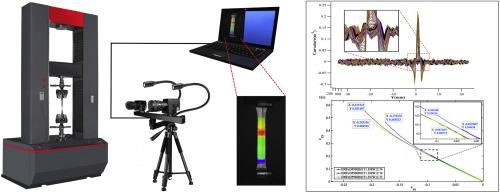Novel method to assess anisotropy in formability using DIC
IF 7.1
1区 工程技术
Q1 ENGINEERING, MECHANICAL
International Journal of Mechanical Sciences
Pub Date : 2024-10-16
DOI:10.1016/j.ijmecsci.2024.109782
引用次数: 0
Abstract
In this study, a novel technique was developed to identify localized neck of a tensile sample based on the curvature of the surface that is expected to work with any metal in which a localized neck forms prior to fracture. Moreover, a MATLAB-based computational tool has been developed to conduct advanced mathematical computations and numerical analysis on data generated from uniaxial tensile test of DP980 steel coupled with Digital Image Correlation (DIC) based on the novel curvature method. The presented curvature technique is a geometry-based approach that uses the specimen's surface profile and groove geometry to detect localized necking, avoiding the limitations of strain-based methods in distinguishing between localized and diffuse necking. A detailed analysis was conducted on the accuracy of the onset and anisotropy of localized neck. The results of the study revealed that specimens fabricated with 30-degree orientation with respect to the Rolling Direction (RD) of the sheet metal, exhibit a higher level of total strain at the onset of the localized necking, indicating the influence of anisotropy on the material's behavior for DP980. Moreover, consistent R-values were observed among specimens with the same orientation with respect to the RD, exhibiting a rising trend of R-value for orientations from zero to 60-degree, followed by a decrease from 60 to 90-degree. Furthermore, the results exhibited a negative linear relationship between R-values and the magnitude of thinning strain.

利用 DIC 评估成形性各向异性的新方法
在本研究中,开发了一种新技术,可根据表面曲率识别拉伸样品的局部颈部,该技术预计可用于在断裂前形成局部颈部的任何金属。此外,还开发了一种基于 MATLAB 的计算工具,用于对 DP980 钢单轴拉伸试验产生的数据进行高级数学计算和数值分析,并根据新颖的曲率方法结合数字图像相关性 (DIC)。所介绍的曲率技术是一种基于几何形状的方法,它利用试样的表面轮廓和沟槽几何形状来检测局部颈缩,避免了基于应变的方法在区分局部颈缩和弥散颈缩方面的局限性。研究人员对局部缩颈的发生和各向异性的准确性进行了详细分析。研究结果表明,与板材轧制方向(RD)成 30 度的试样在局部缩颈开始时表现出更高的总应变水平,这表明各向异性对 DP980 材料行为的影响。此外,在相对于 RD 具有相同取向的试样中观察到了一致的 R 值,从零度到 60 度取向的 R 值呈上升趋势,而从 60 度到 90 度取向的 R 值则呈下降趋势。此外,结果显示 R 值与变薄应变的大小呈负线性关系。
本文章由计算机程序翻译,如有差异,请以英文原文为准。
求助全文
约1分钟内获得全文
求助全文
来源期刊

International Journal of Mechanical Sciences
工程技术-工程:机械
CiteScore
12.80
自引率
17.80%
发文量
769
审稿时长
19 days
期刊介绍:
The International Journal of Mechanical Sciences (IJMS) serves as a global platform for the publication and dissemination of original research that contributes to a deeper scientific understanding of the fundamental disciplines within mechanical, civil, and material engineering.
The primary focus of IJMS is to showcase innovative and ground-breaking work that utilizes analytical and computational modeling techniques, such as Finite Element Method (FEM), Boundary Element Method (BEM), and mesh-free methods, among others. These modeling methods are applied to diverse fields including rigid-body mechanics (e.g., dynamics, vibration, stability), structural mechanics, metal forming, advanced materials (e.g., metals, composites, cellular, smart) behavior and applications, impact mechanics, strain localization, and other nonlinear effects (e.g., large deflections, plasticity, fracture).
Additionally, IJMS covers the realms of fluid mechanics (both external and internal flows), tribology, thermodynamics, and materials processing. These subjects collectively form the core of the journal's content.
In summary, IJMS provides a prestigious platform for researchers to present their original contributions, shedding light on analytical and computational modeling methods in various areas of mechanical engineering, as well as exploring the behavior and application of advanced materials, fluid mechanics, thermodynamics, and materials processing.
 求助内容:
求助内容: 应助结果提醒方式:
应助结果提醒方式:


